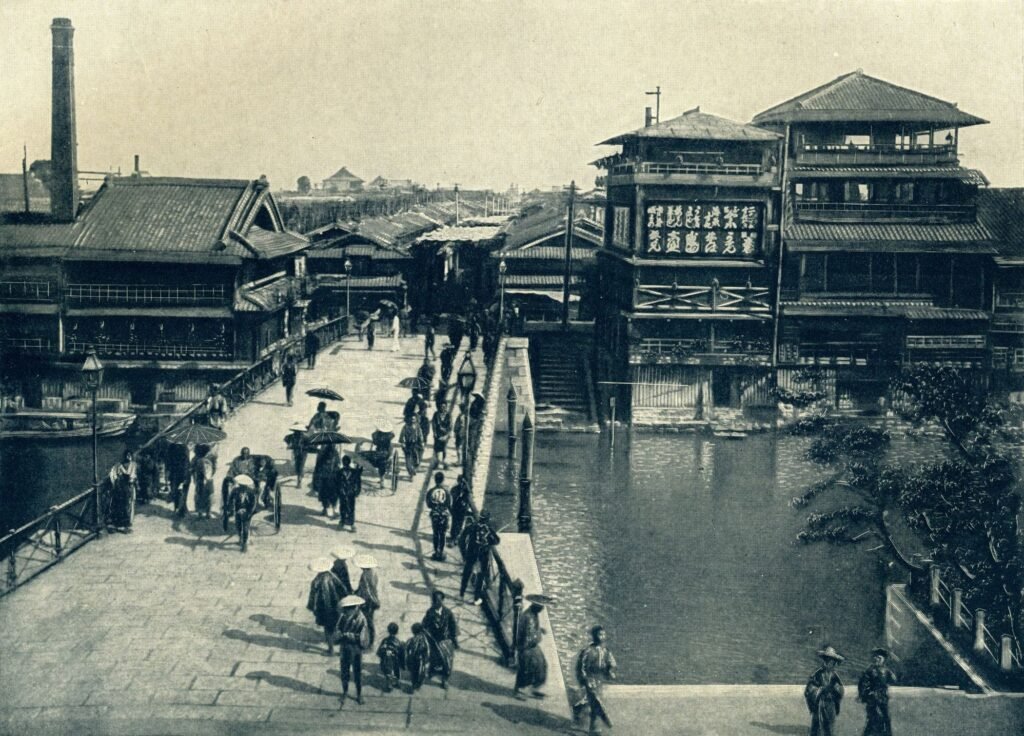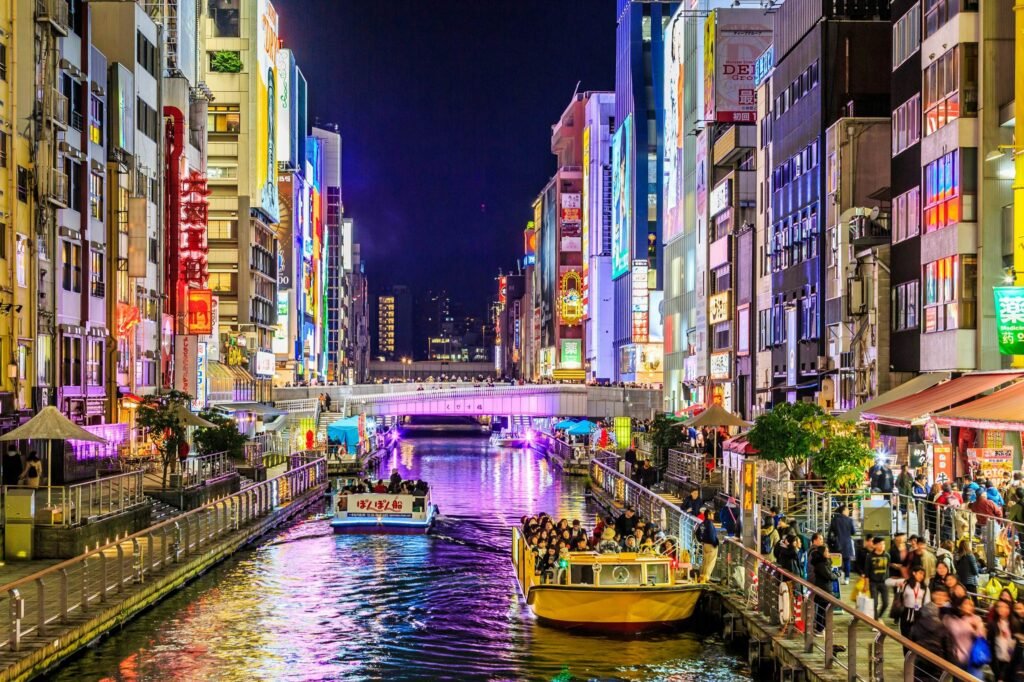Osaka Then and Now
Osaka Then
Osaka is a prominent city located in the south-central region of Japan’s main island, Honshu.
It serves as the capital of Osaka fu, an urban prefecture, and is a vital hub in the Keihanshin Industrial Zone.
This zone, which also includes the neighboring cities of Kōbe and Kyoto, forms the second-largest urban and industrial agglomeration in Japan, after the Greater Tokyo Area.
The region is known for its significant economic contributions, bustling port activities, and well-developed infrastructure, making it a key center for business, trade, and culture in the country.
The name “Ōsaka” itself is derived from the Japanese words for “large hill” or “large slope,” which reflect the city’s geographic features.
Although the city’s historical name was Naniwa, it is unclear when the name Osaka began to replace it in common usage.

The earliest written reference to Osaka dates back to 1496, indicating that the name has been in use for several centuries.
Over time, Osaka has grown from a small settlement to a major metropolitan area, known not only for its economic significance but also for its rich cultural heritage and culinary traditions, making it one of Japan’s most dynamic and influential cities.
Related Article: Busan Then and Now
Osaka History
Osaka, a major city in Japan, has a rich and diverse history that spans thousands of years.
The earliest evidence of human settlement in the area dates back to the Jōmon period (around 7,000 BCE).
During this time, the Uemachi Plateau, which forms a 12 km long peninsula, was an ideal location for early inhabitants.
Its favorable geological conditions, including abundant fresh water and lush vegetation, made it a prime spot for settlement.
Related Article: Taipei Then and Now
Additionally, its defensible position helped protect it from military threats.
Archaeological findings, such as the Morinomiya ruins in the central Chūō-ku district, suggest the presence of a thriving community, with evidence of food consumption, tools, and rice processing dating back over 2,000 years.
As Japan transitioned from the Jōmon to the Yayoi period (300 BCE–250 CE), permanent settlements began to grow, especially as rice farming became more widespread.
Osaka’s strategic location continued to benefit it, and by the third century CE, the grand Sumiyoshi-taisha shrine was established near the harbor.
Related Article: Ho Chi Minh City Then and Now
This Shinto shrine, commissioned by Empress Jingū, became an important cultural and religious landmark, influencing the design of other Shinto shrines.
In the Kofun period (c. 250–600 CE), Osaka’s development as a port city became more pronounced.
The port of Naniwa-tsu emerged as one of the most vital in Japan, facilitating trade with other parts of the country and the Asian continent.
The construction of large keyhole-shaped burial mounds, or kofun, in the Osaka plains, reflects the concentration of political power in the area.
Related Article: Manila Then and Now

Osaka was increasingly recognized as an important political and cultural center, especially during the reign of Emperor Kōtoku, who briefly made Naniwa the capital of Japan in the 7th century.
However, Osaka’s prominence as a capital was short-lived. The capital moved to Asuka, then later to Nara, but Naniwa remained an essential hub for maritime trade and communication.
Throughout the Nara and Heian periods, Osaka retained its importance as a transportation and trade center, especially as the city maintained its connection between the ancient capitals of Japan and other regions of Asia.
The city experienced significant developments during the Edo period (1603–1867) when Osaka became a major economic center.
Related Article: Jakarta Then and Now
The rise of a wealthy merchant class led to the creation of the Dōjima Rice Exchange in 1697, where the world’s first futures market in rice was established.
The city also flourished as a center of culture, with its theaters hosting famous performances of Kabuki and Bunraku (puppet theater).
In the 20th century, Osaka’s growth continued as it became a focal point for Japan’s industrialization, earning it the nickname “the Manchester of the Orient.”
However, the city faced hardships during World War II, with significant air raids that caused widespread destruction.
Related Article: Guangzhou Then and Now
Despite these challenges, Osaka rebounded after the war, rapidly rebuilding its infrastructure and economy.
By the 1960s, the city’s population had grown significantly, and it became a major financial and multicultural hub.
Today, Osaka is known as a global metropolis that blends tradition with modernity.
Related Article: Shenzhen Then and Now
The city is home to numerous cultural landmarks, including Osaka Castle, Sumiyoshi Taisha Shrine, and Shitennō-ji, Japan’s oldest Buddhist temple.
With a strong cultural, educational, and industrial base, Osaka continues to be one of Japan’s most influential and vibrant cities.
It hosts international events, including the 1970 World Expo and the 1995 APEC Summit, and remains a center of media, arts, and technology.
Related Article: Beijing Then and Now
Osaka Now

Osaka is a dynamic and vibrant city located in the Kansai region of Japan, making it one of the most important urban centers in the country.
As the capital of Osaka Prefecture and Japan’s third-most populous city, Osaka is a key economic and cultural hub.
With a population of approximately 2.7 million people as of the 2020 census, it forms a significant part of the Keihanshin Metropolitan Area, which includes neighboring cities like Kobe and Kyoto.
Related Article: Mumbai Then and Now
This sprawling urban area is the second-largest in Japan, home to over 19 million residents, and ranks as the 10th-largest metropolitan area in the world.
Historically, Osaka has played an essential role in Japan’s development, particularly during the Kofun period (300–538 AD), when it became an important port city.
The city was briefly the imperial capital during the 7th and 8th centuries, underlining its historical significance in shaping Japan’s political and economic foundations.
Related Article: Kuala Lumpur Then and Now
Over time, Osaka’s strategic location along the Yodo River delta, at the eastern edge of the Inland Sea, contributed to its status as an economic powerhouse.
The city enjoys a temperate climate, with cool winters and hot, humid summers.
Annual rainfall averages around 1,360 mm (54 inches) and Osaka is occasionally affected by typhoons, which typically occur in September and can cause significant damage.
Related Article: Bangkok Then and Now
The city’s location and geographical features, including its proximity to neighboring cities like Kobe and its surrounding rivers, add to its role as a major urban center.
Osaka has long been known for its high cost of living. For several years, it ranked among the most expensive cities in the world, according to the Forbes list of the most expensive places to live. While it was the second most expensive city in 2009, it had slipped to fifth place by 2020.
This reflects both the city’s economic importance and the high demand for living space in its densely populated urban environment.
Related Article: Seoul Then and Now
One of the most iconic structures in Osaka is Abeno Harukas, which opened in 2014 and remains the tallest skyscraper in Japan at 300 meters.
This impressive landmark overtook the Yokohama Landmark Tower in height until it was surpassed by Tokyo’s Azabudai Hills Main Tower in 2022.
Abeno Harukas symbolizes Osaka’s modern urban development and its ongoing influence as a leading city in Japan’s economy and culture.
Related Article: Tokyo Then and Now
FAQs
Osaka is famous for its vibrant food scene, particularly street food like takoyaki (octopus balls) and okonomiyaki (savory pancakes).
It’s also known for its historical landmarks like Osaka Castle, bustling districts such as Dotonbori, and as a major center for business, commerce, and entertainment in Japan.
No, Osaka is not a Pakistani company. It is a major city in Japan, known for its rich history, culture, and economic significance.
Yes, Osaka is different from Tokyo in several ways. While Tokyo is the capital and the largest city in Japan, Osaka is known for its more laid-back, friendly atmosphere and is often seen as the “kitchen of Japan” due to its famous food culture.
Tokyo is a global financial hub, whereas Osaka has a strong emphasis on commerce and tourism.
Osaka, like much of Japan, is not predominantly English-speaking. While many people working in the tourism and hospitality industries may understand some English, it is not widely spoken in everyday life, and basic knowledge of Japanese is often necessary to communicate effectively.






























